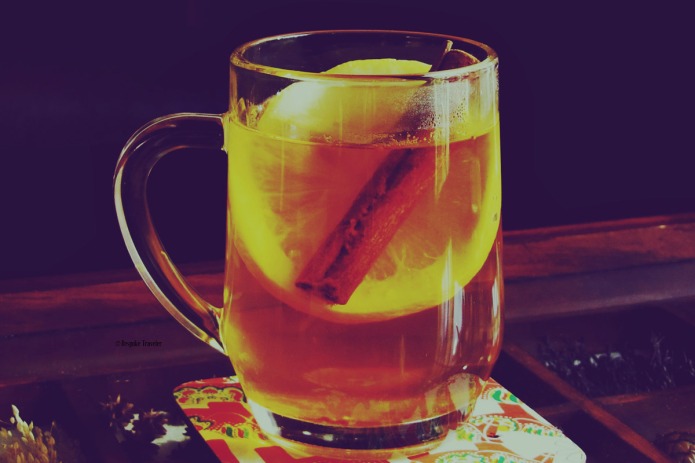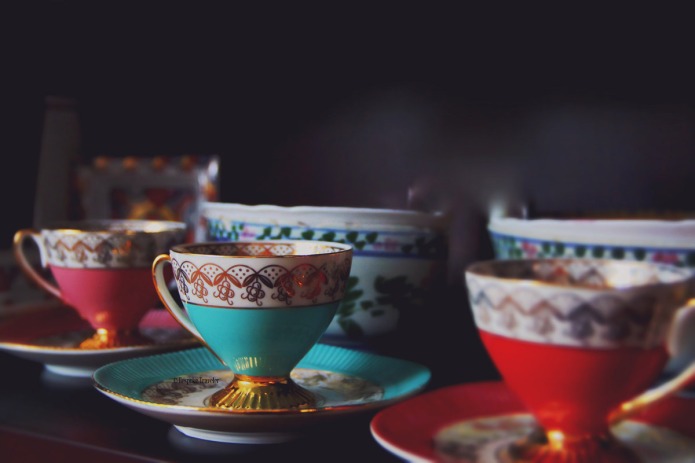 Learning is an ongoing process for me, but sometimes it is necessary to unlearn. To clear the slate of old biases, to let go of cliched ideas, to sweep the cobwebs away. That’s when I fill the kettle with water, set it to boil. I linger in anticipation for the whistle. I bring out my favorite cup. I debate over Assam, Darjeeling, matcha, silver needle, and rooibos — planning which one will be the most appropriate for my ruminations.
Learning is an ongoing process for me, but sometimes it is necessary to unlearn. To clear the slate of old biases, to let go of cliched ideas, to sweep the cobwebs away. That’s when I fill the kettle with water, set it to boil. I linger in anticipation for the whistle. I bring out my favorite cup. I debate over Assam, Darjeeling, matcha, silver needle, and rooibos — planning which one will be the most appropriate for my ruminations.
 Inspiration comes best from the citrus bergamot of earl grey. The arms of sweet chamomile provide comfort. Visions emanate from the dusky bloom of Lapsung Souchong. There is a tea for every need, every occasion: the robustness of morning cuppa to begin my day, the pep of Sencha to revive my sinking spirit, the calmness of herbs to soothe, the warmth of spiced chai on a winter’s eve.
Inspiration comes best from the citrus bergamot of earl grey. The arms of sweet chamomile provide comfort. Visions emanate from the dusky bloom of Lapsung Souchong. There is a tea for every need, every occasion: the robustness of morning cuppa to begin my day, the pep of Sencha to revive my sinking spirit, the calmness of herbs to soothe, the warmth of spiced chai on a winter’s eve.
 Every tea has its particular requirements as well: the right water temperature, the correct steeping time, the appropriate condiment. It is in this space of engagement, in the art of making tea, that true abundance seeps in. As I wait, progressing from one movement to the next, my surroundings take on presence. While my hands occupy themselves with pouring, adding, lifting, my mind is an emptiness in which the threads of innumerable notions, conversations, and concepts fuse to form new patterns.
Every tea has its particular requirements as well: the right water temperature, the correct steeping time, the appropriate condiment. It is in this space of engagement, in the art of making tea, that true abundance seeps in. As I wait, progressing from one movement to the next, my surroundings take on presence. While my hands occupy themselves with pouring, adding, lifting, my mind is an emptiness in which the threads of innumerable notions, conversations, and concepts fuse to form new patterns.
 The Chinese tea ceremony is a deliberate process instilled with thoughtfulness. Self-reflection blooms within the complete devotion to preparing tea. Harmony, balance, and tranquility possess each gesture, turning motion into grace. One is reminded of the yin-yang of nature’s rhythms. Performed with the proper attitude, the tea ceremony becomes a form of meditation.
The Chinese tea ceremony is a deliberate process instilled with thoughtfulness. Self-reflection blooms within the complete devotion to preparing tea. Harmony, balance, and tranquility possess each gesture, turning motion into grace. One is reminded of the yin-yang of nature’s rhythms. Performed with the proper attitude, the tea ceremony becomes a form of meditation.
 Though I make tea on a less ritualistic level, I encounter an equal degree of zen during the procedure. As I rinse the teapot and mug in warm water, I wash away my distractions. Sniffing the fragrance of the chosen leaves, I forget my limitations. While admiring the simple pleasing quality of the sample, I return to gratitude. As the infusion soaks, so do my contemplations. With every sip there is a reevaluation of what I understand, an appraisal of everything I know. In pursuing the technique of brewing tea, I master the art of unlearning.
Though I make tea on a less ritualistic level, I encounter an equal degree of zen during the procedure. As I rinse the teapot and mug in warm water, I wash away my distractions. Sniffing the fragrance of the chosen leaves, I forget my limitations. While admiring the simple pleasing quality of the sample, I return to gratitude. As the infusion soaks, so do my contemplations. With every sip there is a reevaluation of what I understand, an appraisal of everything I know. In pursuing the technique of brewing tea, I master the art of unlearning.
BT’s CHINESE TEA CEREMONY RECIPE
Serves 4 Total Time: 25 minutes
WHAT YOU NEED
1 Porcelain or clay pot
1 tea pitcher
1 large bowl or serving tray
1 tea strainer
4 cups
1 tea spoon
1 tea towel
3 cups (710 grams) water
4 tsp (25 grams) oolong tea*
WHAT TO DO
1. Rinse teapot and cups in warm water for 2-3 minutes. Alternately, you can soak them in a tub of warm water for the same amount of time.
2. Boil water in a kettle to 190° F (88° C). Using tea spoon, drop in 4 scoops of oolong tea leaves into teapot. Place teapot upon serving tray or in large bowl. From shoulder height pour hot water into teapot until it overflows.
3. Immediately pour “tea” from pot into the cups through the strainer. Use the towel to protect your hands. This brew is not meant to be drunk, but to season the containers. Dump out the liquid in both the cups and the pot, but do not discard the tea leaves.
4. Hold kettle just above teapot and pour 3 cups of the boiled water into teapot. Make sure the water completely covers all the tea leaves. Close the lid of the pot. Allow tea to steep for 5 minutes. Enjoy conversing with guests while waiting.
5. Pour tea from pot into pitcher through strainer. Transfer tea from pitcher to cups. Serve guests first.
6. Cradling the cup in both hands, inhale the aroma of your beverage. Take a first small sip, allowing tea to roll around your tongue and coat your mouth. Take a second, large sip. Let the beverage warm you. The third, final sip should reveal the aftertaste.
7. After the first round is finished, oolong tea can be steeped five more times if desired. Once guests have drunk enough tea, scoop out the soaked leaves for them to admire.
* BT Tip: If you do not prefer the taste of oolong, you may choose to use Pu’er, which has a grassier, earthy flavor to it.
Discover more from Bespoke Traveler
Subscribe to get the latest posts to your email.





Thanks for this profundity, and warmth. So much contained in a single ritual, clarity through process, metaphors abound! Beautiful!
Your wonderful praise is so encouraging. Thank you for stopping by to read my story and share your thoughts.
Unfortunately, tea is not my cup of tea! But I feel completely ZEN when I read your description, ritually or not about preparing a cup of tea. 🙂
Best regards, Heidi
That is indeed a compliment, coming from a non-tea lover. Thank you!